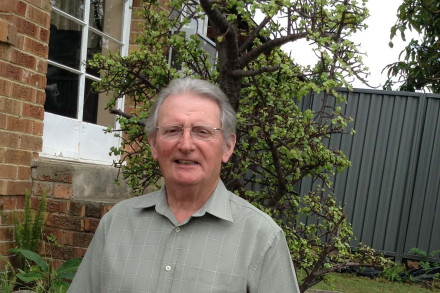Interviewer: Siobhán McHugh for National Library of Australia
Among Liam O’Mahony’s prized possessions is his first ever membership card for the Irish National Association, a membership that he took out shortly after arriving in Sydney from Ireland on the Fairsky in 1961. Born in west Cork, Liam attended the nearby National School and recalls the local game of Irish ‘road bowling’ where an iron or steel ball is hurled along a set course with the player with the fewest throws being the winner. The family had a 100 acre mixed farm and, although they never had much ready money, they were comfortable and not in want. The practice of Catholicism was a significant part of daily life and his mother was proud of the fact that she had a brother, a priest, out in Melbourne. Liam feels she might have had hopes of him becoming a priest:
… a lot of the neighbours around they had a priest in the family so deep in her own mind I would feel she may have had that kind of hope but unfortunately for her it didn’t work out … at that time there was a huge respect not only for the priest but for the family that happened to have a priest in the house … one of [the] sons became a priest and that brought great joy to the parents, to the neighbours and everyone else …at that time when I was growing up, young people were overawed by the presence of a priest.
Perhaps more significant for Liam was the fact that this part of west Cork was steeped in the story of Ireland’s early 20th century fight for independence. Indeed his National School was at Béale na Bláth where the great revolutionary leader from Cork and Commandant General of the new Irish National Army, Michael Collins, was ambushed and killed during the Irish Civil War of 1922/1923. Liam’s father was involved in the War of Independence, imprisoned in Spike Island in Cork Harbour, and later became a prominent figure in local politics. All of which makes it not at all surprising that on arriving in Australia, Liam joined that most Irish nationalist of Irish associations in Australia, the INA.
At the time the INA Wednesday and Sunday night dances were the main Irish show in town. While, in Liam’s view, these were not as exciting and lively events as the developing show band scene back in Ireland, they were still attractive to an Irish immigrant and Irish/Australian audience. Good performers such as Scotsman Johnny McLeod provided dance tunes and crooner Tommy McTaggart provided nostalgic glimpses of the old land with songs like ‘That little old mud cabin on the hill’ and ‘The Maid of the Sweet Brown Knowe’. Irish/Australian parents approved of the INA dances, where their daughters might find a suitable husband.
By 1967 Liam was a committee member of the INA. From the vantage point of having had a good deal to do with INA finances – Liam qualified in Australia as an accountant – he has been able to closely observe the economic ups and downs of the organisation. An outstanding loan used to develop the current building in Devonshire Street needed to be serviced and this led to the holding of ‘housie’ or ‘bingo’ sessions for locals on Friday and Saturday nights to raise money. The steam ran out of the ‘housie’ sessions in the late 1960s and there was a strong move to develop a licensed club on the premises that could attract drinkers and those wanting to socialise as much as attend other events. In 1974 the Gaelic Club in the INA building obtained a licence and Liam was one of the witnesses called by the Licensing Court to give evidence that the INA was a genuine community and cultural organisation capable of running a licensed premises.
While the period leading up to the opening of the Gaelic Club was a good time for the INA, as Liam sees the story, the club has had a turbulent career. One event, which cost it dearly, was the failure to get a sufficient audience for the broadcast of the All-Ireland Final in 1977 at a central Sydney cinema, so leaving the club with a significant debt. During the 1980s there were good attendances at club functions but once other drinking establishments were allowed to open late, the crowds slowly faded away. While the club has drifted on to the present day, Liam feels that it’s hard to attract the younger Irish backpackers or immigrants to the venue in a situation where there is so much competition from newer Irish pubs and other establishments. Armed with their iPhones, the younger crowd can organise to meet at any number of venues around the city and the Gaelic Club is perhaps a bit far from that faster flowing action.
Despite the challenge to keep the INA going Liam is rightly proud of its achievements. It is still there, still successfully promoting Irish culture in the 21st century 100 years after its foundation in 1915. Over the years, the organisation has brought much joy and good entertainment to thousands of people and with the right effort it could continue to do so. In this respect Liam feels, and this is something than can be said of all such organisations, that you get out of it what you are willing to put in:
… it’s a bit like the famous line from JFK ‘do not ask what your country can do for you, ask yourself what you can do [for your country]’, it’s the same thing with a club … that’s why clubs go bad … a person has got to see what they can put into it and mix and meet and get other people in there.

